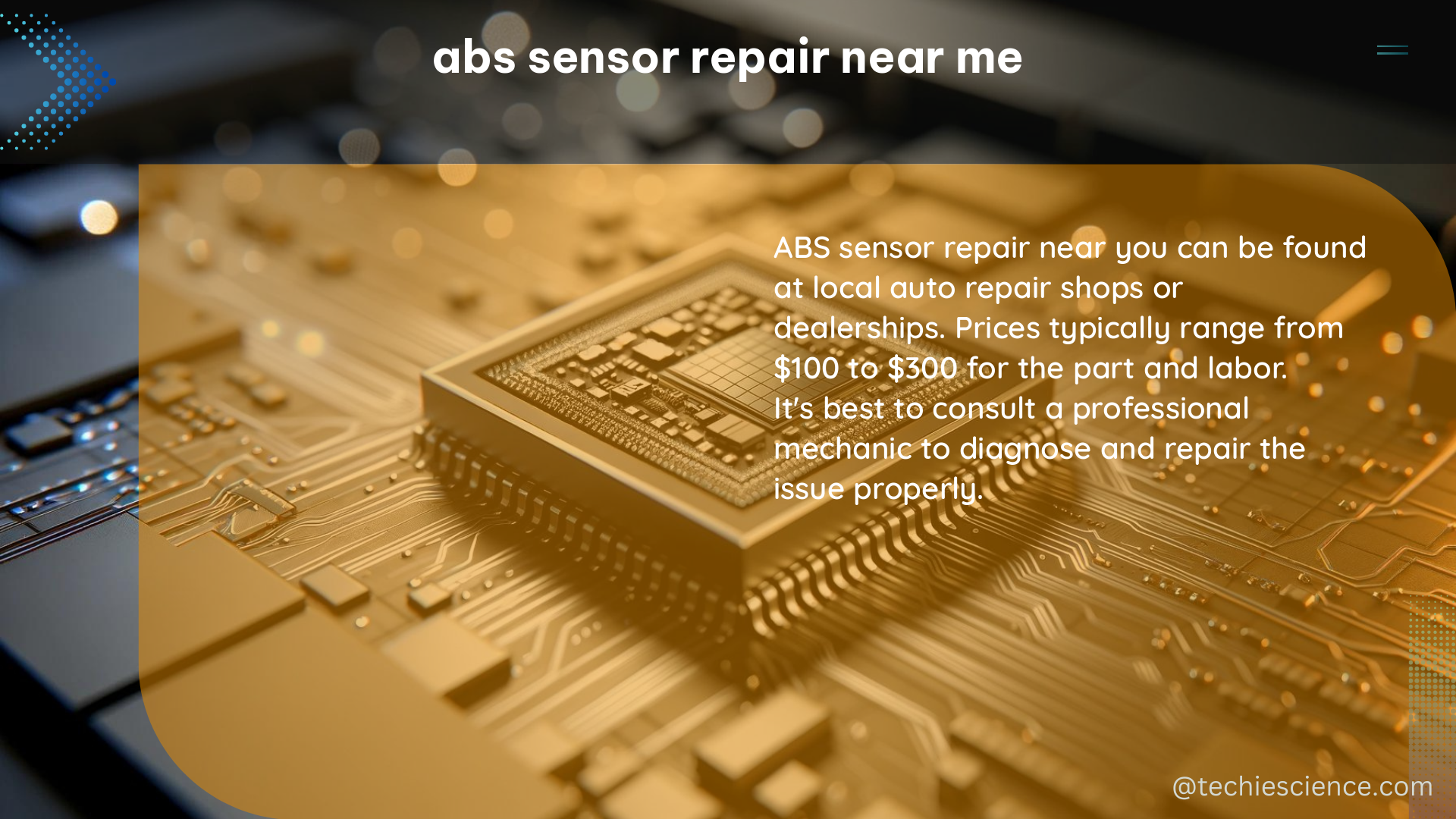The Anti-lock Braking System (ABS) is a crucial safety feature in modern vehicles, responsible for preventing wheel lockup during braking, allowing the driver to maintain steering control and avoid skidding. The ABS sensor is a critical component of this system, measuring the rotational speed of each wheel and communicating this information to the ABS control module, which then adjusts the brake pressure accordingly.
Understanding ABS Sensors
ABS sensors come in two main types: active and passive. Active sensors are proximity sensors with integrated electronics that are supplied with a defined voltage from the ABS control unit, while passive sensors do not require a separate power supply from the control unit.
Active ABS sensors typically use a Hall effect sensor to detect the rotation of a toothed wheel or reluctor ring, which is attached to the wheel hub. As the wheel rotates, the sensor detects the changing magnetic field, generating a signal that is sent to the ABS control module.
Passive ABS sensors, on the other hand, use an inductive coil to detect the changing magnetic field generated by a toothed wheel or reluctor ring. These sensors do not require a power supply from the control unit, as they generate their own signal based on the changing magnetic field.
It is essential to consult the specific manufacturer’s specifications and the respective vehicle manufacturer’s guidelines when diagnosing and repairing ABS sensor issues, as active and passive sensors cannot always be easily distinguished by appearance.
Diagnosing ABS Sensor Issues

When an ABS sensor is not functioning correctly, it can lead to various issues, such as the ABS light turning and staying on, a grinding or droning noise when braking, or a decrease in braking performance. To diagnose the problem, a technician will typically follow these steps:
-
Inspect the ABS Sensor: Visually inspect the ABS sensor for any signs of damage, such as cracks, corrosion, or loose connections. Check the sensor’s mounting and ensure it is securely in place.
-
Check the Sensor Wiring: Inspect the wiring harness and connections between the ABS sensor and the control module for any signs of damage, such as fraying, loose connections, or corrosion.
-
Perform Electrical Tests: Use a multimeter or oscilloscope to test the sensor’s output signal and ensure it is within the manufacturer’s specifications. This may involve checking the sensor’s resistance, voltage, and frequency.
-
Consult Diagnostic Trouble Codes: Retrieve any diagnostic trouble codes stored in the ABS control module using a suitable diagnostic tool. These codes can provide valuable information about the specific issue with the ABS sensor.
-
Verify Sensor Functionality: If the sensor appears to be functioning correctly, the issue may be with the ABS control module or other components in the braking system. Further testing and diagnosis may be required.
Replacing an ABS Sensor
If an ABS sensor is found to be faulty, it will need to be replaced. The cost of an ABS sensor replacement can vary depending on the make and model of the vehicle, as well as the labor rates in the local area. According to RepairPal, the average cost for a Wheel Speed Sensor Replacement ranges between $209 and $265, with labor costs estimated between $62 and $78, and parts priced between $147 and $187.
When replacing an ABS sensor, it is essential to follow the maintenance and safety instructions of the vehicle manufacturer and the product-specific assembly instructions. Additionally, it is recommended to replace brake discs in pairs and together with new brake pads to ensure the proper functioning of the braking system.
Importance of Proper Diagnosis and Repair
Proper diagnosis and repair of ABS sensor issues are crucial for maintaining the safety and performance of a vehicle’s braking system. Incorrect diagnosis or improper repair can lead to further issues, such as decreased braking performance, increased wear on other components, or even a complete failure of the ABS system.
To ensure a reliable diagnosis and repair, technicians should have access to the necessary documentation, diagnostic tools, and technical know-how. This includes:
- Specific manufacturers’ specifications and the respective vehicle manufacturer’s guidelines
- Suitable diagnostic tools, such as a multimeter or oscilloscope
- Sufficient technical knowledge and experience in ABS system diagnosis and repair
By following these best practices, technicians can accurately identify and address ABS sensor issues, ensuring the safety and reliability of the vehicle’s braking system.
Conclusion
ABS sensor repair is a critical aspect of maintaining a vehicle’s safety system. By understanding the different types of ABS sensors, following proper diagnostic procedures, and adhering to manufacturer guidelines, technicians can effectively identify and address ABS sensor issues, ensuring the continued safe operation of the vehicle.
References:
– Wheel Speed Sensor Replacement Cost – RepairPal Estimate. (n.d.). Retrieved from https://repairpal.com/estimator/wheel-speed-sensor-replacement-cost
– ABS Wheel Sensor Replacement in Reno, NV. (n.d.). Retrieved from https://renovulc.com/service-ABSWheelSensorReplacement.html
– BRAKE DISCS AND WHEEL SPEED SENSORS IN ABS SYSTEMS. (n.d.). Retrieved from https://www.hella-pagid.com/hellapagid/assets/media/Brake_Disc_ABS_PAGID_EN.pdf

The lambdageeks.com Core SME Team is a group of experienced subject matter experts from diverse scientific and technical fields including Physics, Chemistry, Technology,Electronics & Electrical Engineering, Automotive, Mechanical Engineering. Our team collaborates to create high-quality, well-researched articles on a wide range of science and technology topics for the lambdageeks.com website.
All Our Senior SME are having more than 7 Years of experience in the respective fields . They are either Working Industry Professionals or assocaited With different Universities. Refer Our Authors Page to get to know About our Core SMEs.